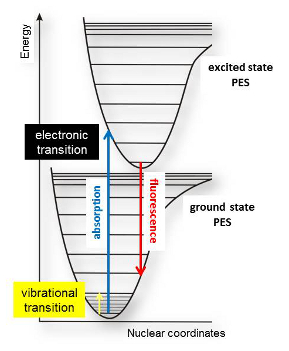First-principles study of Aromatic Cokes intermediates in the MTO-process via Computational UV-Vis and fluorescence spectra
First-principles study of Aromatic Cokes intermediates in the MTO-process via Computational UV-Vis and fluorescence spectra
Promotor(en): K. Hemelsoet /15_SPEC07 / Nanoporous materials, SpectroscopyAromatic coke-like species are known to grow in the spacious zeolite cages during the methanol-to-olefins (MTO) process involving SAPO-34. Ultimately, these large polyaromatics block the diffusion through the pores and deactivate the catalyst completely. Overall, spectroscopy is crucial for characterization of chemical intermediates or materials. Depending on the type of information one is interested in, interactions with different radiation sources can be studied. In this master thesis, we focus on UV-Vis and fluorescence spectroscopy involving light in the UV (190-380 nm) or visual (380-750 nm) range, leading to electronic transitions between a ground and excited state surface. These transitions are relevant for large conjugated systems, such as polyaromaticsformed in the chabazite (CHA) cages. Experimental studies focusing on confocal fluorescence spectra already revealed the presence of aromatic intermediates (see Figure 1); however it remains difficult to truly characterize the involved compounds when only using experimental data. Detailed characterization also requires the availability of accurate theoretical spectra. These simulations are very challenging and require good insight in: (1) the chemical process at play and the possible reaction or coke intermediates that can be formed, (2) the theoretical method used to model the electronic excited states and (3) the influence of the zeolite environment on the optical spectra.

Figure 1. Experimental confocal fluorescence measurements of MTO at 600 K over H-SAPO-34 [from Qian et al, Chem. Eur. J. 2013, 19, 11204-11215]. The colors indicate the presence of fluorescent coke intermediates in the zeolitic pores.Aim The aim of this master thesis is to use ab initio techniques and investigatepolyaromatics representing coke intermediates in a CHA topology. Various important techniques, amongst which UV/Vis and fluorescence spectroscopy will be applied to characterize the involved intermediates in the important methanol-to-olefins process. Initial simulations will be performed on molecular model systems, focusing on the influence of temperature, which is a crucial process parameter and highly relevant for the MTO process. Both static and dynamic simulations will therefore be employed. The main challenge involves inclusion of the zeolitic environment. Incorporation of the nanoporous environment in the simulations forms the main objective of this thesis. This will require the use of periodic unit cells, combined with newly developed methodologies.
The main challenge of this master thesis is the combination of the theoretical simulations with the interpretation of the resulting spectra. Successful unraveling of the data requires a lot of insight in the electronic structure of the complex catalyst materials used in chemical processes. This topic contributes to current research activities at the Center for Molecular Modeling and intensive coaching will be provided. There will be close interaction with other researchers working on zeolite-catalyzed processes and nanoporous materials (research headed by Prof. V. Van Speybroeck). This thesis ensures that the interested student gains a profound insight in the aromatic coke species and the processes responsible for their optical activity. Insight in the influence of the zeolitic environment is crucial for a variety of industrially important zeolite-catalyzed reactions. The interested student can focus on particular items of this thesis research, depending on his/her specific interests.

Figure 2. Energy diagram of a molecular system; the ground and first excited state are depicted. Electronic transitions are indicated: absorption in blue and fluorescence in red.
- Study programmeMaster of Science in Chemical Engineering [EMCHEM]KeywordsMolecular modeling, Methanol-to-olefins process, SpectroscopyRecommended coursesMolecular Modeling of Industrial Processes


